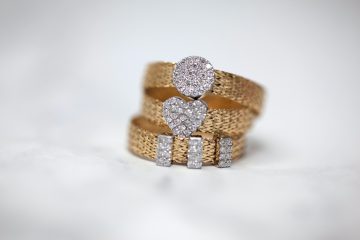The emerald is one of the world’s most sought after and valuable gems and consists of the mineral beryl. The bright green color that is characteristic of emeralds comes from elements of chromium, vanadium, or iron (or a mixture of these three) that are pressed into the crystal during the formation process in the bedrock.
The name emerald derives Greek and Latin, where the word means green stone. The emerald is considered one of the four major gems along with diamond, ruby , and sapphire.
The emerald has been appreciated for its beauty and used as decoration, in jewelry, and as a commodity for thousands of years. The first listed sale of an emerald occurred in a market in ancient Babylon (now Iraq) about 4,000 years before our era. The Egyptian Queen Cleopatra (69 BC – 30 BC) was known for his fascination for emeralds and even had his own and mythical emerald mines. For a long time, the Egyptian mines were the only known source of emeralds.
It took until the arrival of the Spaniards in South America until new discoveries were discovered. In 1558, just a few years after the first conquistadors stepped ashore on the South American coast, emerald deposits were discovered in Muzo in present-day Colombia.
Therefore, it is perhaps no wonder that many of the emeralds that were extracted in Colombia at this time came to Europe and several European royal houses. Precisely the Danish royalty seems to have had a special preference for emeralds. The famous emerald garnish that is part of the Danish crown jewels contains some of the finest and most valuable emeralds in the world. The Danish royal house, taken together, by several gemstones, is considered to be the world’s foremost collection of emeralds.
Emerald gemstones
Emeralds are usually found in bedrock that contains a lot of slate and lime. When emeralds are broken, it is not uncommon to find emeralds that weigh several kilos. But then the whole stone does not consist of pure emerald, only small parts hold the gemstone class. Most emeralds that can be used are small, at a few carats.
But of course, big emeralds are discovered. One of the largest known emeralds ever, the so-called Gachala emerald found in Colombia, weighed 858 carats before it was broken down into smaller parts. Another emerald thistle is the Count of Devonshire, also that of the Muzo mine in Colombia, which weighed a whopping 1,383 carats. The Count of Devonshire can be seen at the Natural History Museum in London.
Extraction places of emerald gemstones
Since the 16th century, Colombia, and especially the mine in Muzo, has been the world’s leading emerald producer. The emeralds from Muzo are famous for their high quality, deep green color, and clarity. Even today, the Colombian mines account for about 60 percent of the world’s emerald production, and the stones from it generally hold exceptionally high quality.
During the 20th century, emeralds were discovered in several other places in the world and competing mines were established. But few of them come close to the Colombian emeralds. Neither in volume nor quality.
Today, emeralds are broken in, among others, Brazil, Tanzania, Australia, India, Zambia, Russia, South Africa, Pakistan, and Zimbabwe. Alongside Colombia, the largest amount of emeralds comes from Brazil.
The Brazilian emeralds often have a fantastic deep green color but few of them are sufficiently clear to be considered the top layer of the emeralds and can rarely compete with the Colombian musos emeralds. Fine quality emeralds are also extracted in Russia, Pakistan, and Zambia. The only known European emerald deposit is in Norway. However, the Norwegian emeralds are generally small and do not hold as high quality as emeralds from southern latitudes.
If we talk about quality there are really only two places that come close to the Colombian emeralds. The two African neighbors Zambia and Zimbabwe. Emeralds from Zambia are of high quality but the mines there do not produce in the vicinity as large volumes as the Colombian.
In Zimbabwe (then South Rhodesia), in 1956, emeralds of incredibly high quality were discovered in the now-famous Sandawana mine. For about 20 years, Sandawana produced emeralds of consistently high quality. It quickly became apparent that the Sandawana emeralds contained a very high concentration of chromium which gave the emeralds an unusually deep green color while maintaining incredibly high quality in general.
The Sandawana emeralds could be sold at hitherto unmatched prices per carat. Sadly, the emerald production there would not last. During the 1970s, a colonial war of liberation broke out in Zimbabwe / Rhodesia that ended with Robert Mugabe coming to power in 1980. Since then, very few emeralds have left Zimbabwe.
The basic rule is that the deeper the green of an emerald, the more sought after and valuable it is. Conversely, lighter green emeralds are worth less. There is even a limit to how bright an emerald may be. Really bright green pieces of beryl are not counted as emeralds but are short and good green beryl.
As mentioned, completely emergencies do not, in principle, ever occur in nature. But some pieces can come really close. Such emeralds are extremely valuable. That being said, inclusions need not make an emerald any less valuable. On the contrary, many believe that smaller faults such as inclusions and cracks make the emerald more beautiful and give it greater depth.
Synthetic emeralds
High-quality emeralds are highly sought after and one of the most exclusive gems. As with all other very expensive materials, it is therefore common for imitations of cheaper materials to be manufactured. An imitation of emerald may consist of plain glass or alternatively colored quartz (rock crystal), but other materials are also present. A well-made imitation can be quite convincing, so watch out if you buy an emerald in private.
It is also possible to make artificial synthetic emeralds in laboratories, in the same way, that you can make diamonds and pearls. In purely technical terms, a synthetic emerald is as much emerald and genuine as one that is broken in a mine when they are of the same chemical composition as a natural one.
Although the synthetic emeralds can be of at least as good quality as natural emeralds (if not better), they are worth significantly less money. It is therefore mandatory for the seller to tell customers that it is a natural or an artificial emerald.
However, artificial emeralds are not necessarily cheap. High-quality synthetic gemstones can often demand more than 100 EUR per carat for their finest synthetic emeralds.
Emerald is a hard material. On Moh’s ten-degree hardness scale used for gemstones and metals, the emerald has a value of 7.5-8. By comparison, industrial steel has a hardness of about 5.5 on the same scale (diamond is a ten). Although an emerald has a hardness of 7.5-8, it is relatively brittle and sensitive to blows and temperature changes.
In addition, emeralds often have plenty of inclusions. Inclusions are small cavities in the stone that contain air or contaminants of other substances. Emeralds can therefore easily crack in a way that is difficult to predict when grinding them.
Because of the brittleness, it was long tricky for jewelers to split and grind emeralds. Early jewelers had major problems with the emeralds bursting into smaller parts during the grinding. Eventually, therefore, a special grinding was developed with the aptly named emerald grinding.
Emerald cut stones have long facets with blunt corners and resemble a pillow to the shape. This means that the risk of stone cracking is radically reduced while producing a stone that reflects a lot of light. The grinding quickly became popular and is also used today on other gemstones such as diamonds, rubies, and sapphires.
It is mainly really nice emeralds that are sanded with emerald grinding or any of the other classic gemstone grinding. Less valuable emeralds, such as those that are not sufficiently clear, are often ground to cabochon and are rarely used in necklaces. A cabochon is oval with rounded upper and flat underside or ball-shaped.



